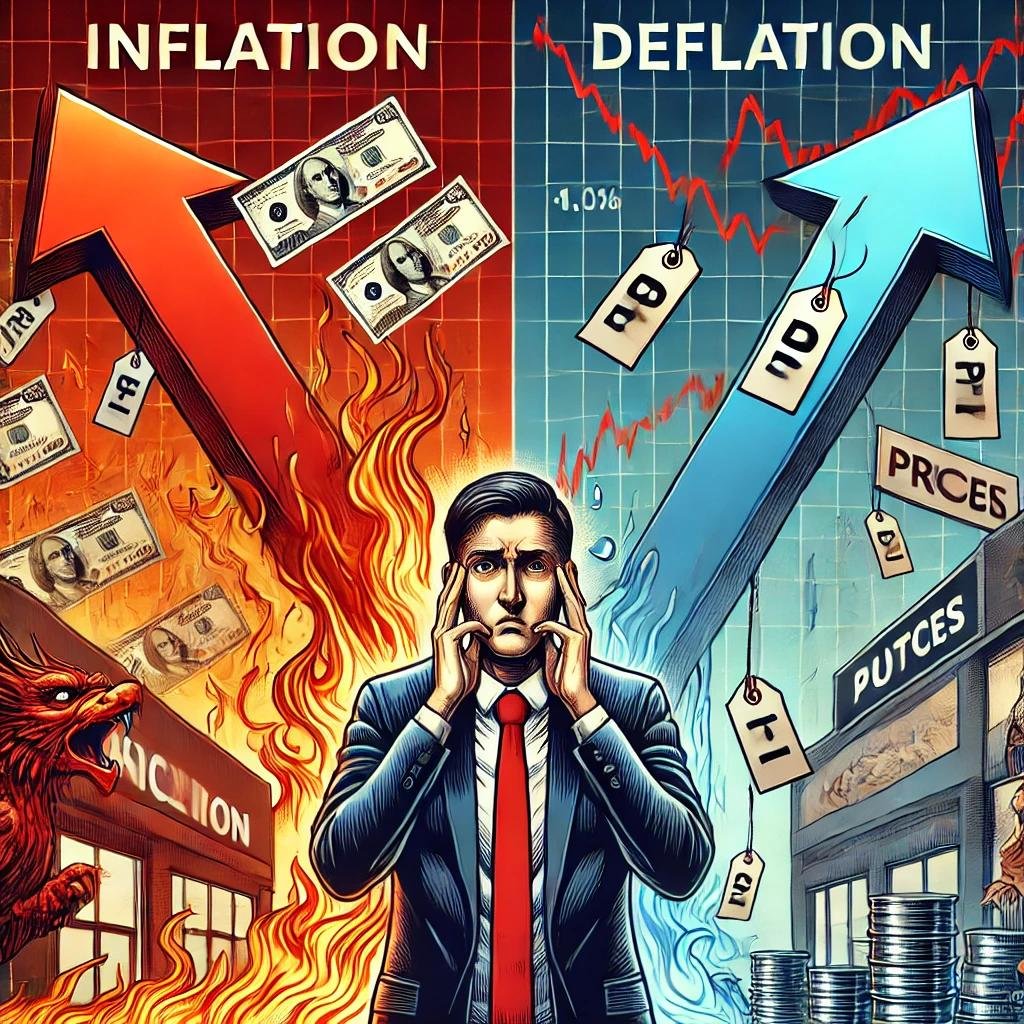Inflation vs. Deflation Explained
Key Differences Between Inflation and Deflation
Inflation vs Deflation: Which is Worse?
🔹 Introduction
Inflation and deflation are two economic forces that shape prices, jobs, and investments worldwide. While inflation erodes purchasing power, deflation can trigger unemployment and economic stagnation. Governments and central banks, like the RBI and Federal Reserve, constantly balance these extremes to protect economies. Interestingly, just as financial markets evolve, technological advancements like Quantum Computing and AI are revolutionizing cybersecurity, impacting global economies in new ways.
This guide explains:
✔ Key differences between inflation and deflation.
✔ Their causes and real-world examples (e.g., Venezuela’s hyperinflation vs. Japan’s deflation).
✔ How they impact businesses, investments, and everyday life.
✔ Strategies to safeguard your finances.
(Source:Investopedia)
🔹 What is Inflation and Deflation?
Inflation = Rising prices over time (e.g., a ₹100 meal costs ₹110 next year).
Deflation = Falling prices (e.g., a ₹100 phone drops to ₹90).
📌 Example:
Inflation: Post-COVID, supply chain disruptions caused prices to surge.
Deflation: During the Great Depression (1930s), prices collapsed, worsening unemployment.
🔹 Key Differences Between Inflation and Deflation
| Factor | Inflation | Deflation |
| Prices | Increase | Decrease |
| Consumer Behavior | Spend Now (Fear of higher prices) | Delay spending (wait for lower prices |
| Economy | Grow (if controlled) | Shinks (business cut jobs) |
| Debt Impact | Easier to repay (with cheaper money) | Harder to repay (money value rises) |
(Source:Clear Tax)
🔹 Causes of Inflation and Deflation
Inflation Causes:
- Demand-Pull: Too much money chasing few goods (e.g., post-pandemic travel boom).
- Cost-Push: Rising oil/raw material costs (e.g., 1970s oil crisis).
- Money Printing: Excess cash floods the market (Zimbabwe’s hyperinflation).
Deflation Causes:
- Low Demand: Consumers stop spending (e.g., Japan’s “Lost Decade”).
- Tech Advances: Cheaper production (e.g., smartphones getting cheaper).
- High Interest Rates: Loans become expensive, reducing spending.
(Source: Study Smarter)
🔹 Effects on the Economy
The Rising Cost Impact:
👍 Pros: Boosts wages, encourages investment.
👎 Cons: Hurts savers, raises living costs.
The falling Cost Impact:
👍 Pros: Short-term bargains for consumers.
👎 Cons: Business losses, wage cuts, recession.
📌 India’s Case: India’s economic landscape remains dynamic, with RBI revising the rising cost forecasts to 4.8% for 2024-25 due to rising food prices. The economy grew by 6.2% in Q3 2024, driven by government spending and rural resilience. However, market volatility persists, with foreign investors pulling funds amid inflation and reduced expenditures. While inflation challenges purchasing power, economic growth signals stability. Understanding these shifts helps individuals and businesses navigate financial decisions effectively. Staying informed about RBI policies, GDP trends, and market movements is crucial for adapting to economic changes and securing long-term financial well-being.
(Source: The Hindu)
🔹 Is Deflation Good or Bad?
Short-Term: Beneficial (cheaper goods).
Long-Term: Dangerous (economic spiral).
📌 Verdict: Mild inflation (2-3%) is healthier than deflation.
🔹 How Central Banks (Governing Authorities) Control Rising Cost / Falling Costs
To Fight Rising Cost:
↑ Interest rates (e.g., RBI’s repo rate hikes).
Reduce money supply.
To Fight Falling Cost:
↓ Interest rates (e.g., US Fed’s 2008 cuts).
Print money (Quantitative Easing).
(Source: Investopedia)
🔹 Impact on Investments
| Scenario | Winners | Losers |
| Rising Cost | Real estate, gold, stocks | Cash holders, bonds |
| Falling Cost | Bonds, cash | Stocks, real estate |
📌 Pro Tip: During inflation, invest in TIPS (Inflation-Protected Bonds).
(Source: Bloomberg)
🔹 FAQs
1️⃣What is the main difference between rising and falling costs in an economy?
When the cost of everyday items goes up over time, people may find their money buys less. On the other hand, when prices drop steadily, things become cheaper, but businesses may struggle to make a profit. The first situation can encourage people to spend quickly, while the second might make them delay purchases, waiting for even lower prices. Both situations impact jobs, savings, and business growth differently.
2️⃣ Why do everyday expenses sometimes rise?
When more people want to buy things but there aren’t enough products available, prices naturally go up. Other times, higher costs for production or services push prices higher. If more money is introduced into circulation without a balance in available goods, the cost of living increases. While a gradual rise can signal a growing economy, if it happens too fast, it can reduce what people can afford in daily life.
3️⃣What causes prices to fall over time?
If people stop buying as much, businesses lower costs to attract customers. Sometimes, improvements in technology make production cheaper, which leads to lower prices. In some cases, stricter financial policies make borrowing harder, reducing how much people spend. While short-term price drops might seem good, if this continues for too long, businesses may struggle to earn enough, causing wages to shrink and job losses to increase.
4️⃣ How does a rise in costs affect daily life?
When living expenses go up, people may need to spend more on food, rent, and transport. Savings lose value if not properly invested. However, in a controlled way, this can encourage businesses to expand, leading to better job opportunities and higher earnings. But if it happens too fast, many people find it harder to afford their usual lifestyle, leading to financial stress and changes in spending habits.
5️⃣ How do falling prices affect businesses?
While lower prices can make things more affordable for buyers, companies may earn less, leading to pay cuts or job reductions. Some businesses may struggle to survive if they cannot maintain their earnings. If people hold off on purchases expecting even lower prices later, businesses suffer even more. However, industries that depend on rapid innovation, such as electronics, may still benefit from falling costs.
6️⃣ How do financial authorities manage these situations?
When everyday costs rise too fast, authorities increase borrowing costs to slow spending and balance the market. If costs are falling too quickly, they do the opposite by making borrowing easier to encourage spending. In extreme cases, they may introduce new measures to increase the flow of money, helping to stabilize businesses and jobs. These adjustments aim to maintain a healthy balance, preventing extreme financial challenges.
7️⃣ Is a gradual rise in costs always a bad thing?
Not necessarily. A slow and steady increase can be beneficial as it encourages businesses to invest and expand, leading to job growth. This can help keep the economy active. However, if costs go up too fast, it can reduce people’s ability to afford necessities, creating financial difficulties. Finding a middle ground is important to ensure people can maintain their standard of living without sudden price shocks.
8️⃣Can steadily falling prices be good for the economy?
If costs decrease for a short period, people can enjoy better deals. However, if this continues for too long, businesses struggle to make profits, leading to lower wages and fewer job opportunities. People may also delay buying, thinking prices will drop even further, which slows economic activity. While lower costs seem attractive at first, a prolonged trend can create long-term challenges for growth and financial stability.
9️⃣ How do changes in prices affect investments?
When living costs rise, certain assets like properties or physical commodities tend to become more valuable, while savings might lose their purchasing power. On the other hand, when prices keep dropping, holding cash or fixed-return investments can be a safer option. Investors usually adjust their strategies depending on whether prices are going up or down, balancing their choices to protect against unexpected changes.
🔟 Is it better for the economy when prices rise or fall?
Neither extreme is ideal. A moderate and controlled rise in costs usually helps businesses and employment remain stable, ensuring steady growth. If costs drop too fast, companies earn less, jobs become scarce, and people hesitate to spend. Financial regulators aim to keep things balanced so that neither extreme disrupts economic stability. A steady, predictable environment allows individuals and businesses to plan ahead with confidence.
🔹 Conclusion
A well-balanced economy requires stability, avoiding extreme fluctuations in the cost of living. When prices steadily increase, businesses thrive, employment grows, and investments yield returns. However, if costs rise too quickly, it becomes difficult for people to afford necessities, impacting savings and future financial security. On the other hand, when prices drop for an extended period, businesses struggle to make profits, leading to job losses and reduced wages. This can discourage spending, slowing down overall economic activity.
Authorities constantly monitor these changes, adjusting financial policies to maintain a stable environment. Their goal is to ensure that people can afford essentials while businesses continue to operate profitably. A steady and predictable financial landscape allows individuals to plan for the future, make informed investment decisions, and maintain a reasonable standard of living.
Ultimately, neither extreme is beneficial in the long run. A controlled and gradual change helps economies function smoothly, supporting both businesses and individuals. Being aware of these shifts helps people make better financial decisions, adapt to changing conditions, and secure their future. Staying informed, making thoughtful choices, and balancing spending and saving are key to maintaining personal financial health in any economic climate.
Understanding inflation vs. deflation helps you:
✔ Plan investments (stocks vs. bonds).
✔ Anticipate price trends (e.g., home loans during inflation).
✔ Advocate for better policies.
Final Tip: Diversify assets to hedge against both risks.
Comment your thoughts
👉 Want to secure your finances from inflation and deflation? Follow our blog for expert financial insights!.
📢📢Unlock Your Online Potential with Hostinger!
Struggling with movies addiction? Turn your screen time into income by creating a money-making website! With Hostinger’s affordable hosting, you can:
✅ Build a blog, e-commerce store, or portfolio in minutes
✅ Monetize through ads, affiliate marketing, or digital products
✅ Enjoy lightning-fast speed & 99.9% uptime
Exclusive 20% OFF for our readers:
Why Hostinger ?
✔ 1-click WordPress install (perfect for beginners!)
✔ 24/7 live chat support
✔ Free SSL certificate (secure your site)
Example Success:
Riya, a former movie addict, now earns ₹50,000/month from her self-care blog—built on Hostinger in just 2 days!
Your Turn:
1️⃣ Sign up with our link
2️⃣ Launch your site (use detox tips as content!)
3️⃣ Start earning while helping others break free!
💡 “Your phone is a goldmine—stop scrolling, start selling!”
**Affiliate Disclosure – “This page contains affiliate links. We may earn a commission at no extra cost to you.

